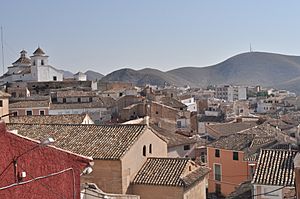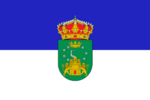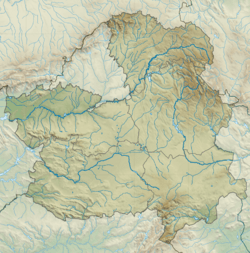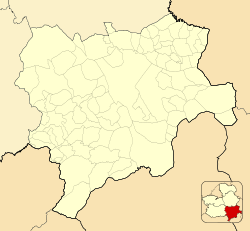Hellín facts for kids
Quick facts for kids
Hellín
|
|||
|---|---|---|---|
 |
|||
|
|||
| Country | Spain | ||
| Autonomous community | Castilla–La Mancha | ||
| Province | Albacete | ||
| Area | |||
| • Total | 781.66 km2 (301.80 sq mi) | ||
| Elevation | 555 m (1,821 ft) | ||
| Population
(2018)
|
|||
| • Total | 30,268 | ||
| • Density | 38.7227/km2 (100.2914/sq mi) | ||
| Demonym(s) | Hellineros or Ilunenses | ||
| Time zone | UTC+1 (CET) | ||
| • Summer (DST) | UTC+2 (CEST) | ||
| Postal code |
02400
|
||
Hellín is a city and a municipality in Spain. It is located in the province of Albacete, which is part of the Castilla–La Mancha region. Hellín covers a large area of about 781.66 square kilometers.
As of January 1, 2020, Hellín had a population of 30,200 people. This makes it the second largest municipality in the province. It is also part of an area known as the comarca of Campos de Hellín.
Contents
A Look at Hellín's Past
There's an old archaeological site near Hellín called Tolmo de Minateda hill. This site shows signs of different groups of people living there over time. These groups include the Iberians, who were ancient people of Spain, the Romans, and the Visigoths.
Some discoveries suggest that Minateda might have been on the Byzantine side of a border called the limes. This border was used by the Roman Empire. The site might also be the Iyih mentioned in an old agreement called the Pact of Theodemir. During the time of Islamic rule, Minateda was probably known as Madinat Iyyuh. However, the Arabic name for Hellín itself was Falyān, which later changed to 'Felín' and then 'Hellín'.
Sulfur Mining and Railways
The area south of Hellín was very important for its Sulfur mines. Sulfur is a yellow chemical element. Because of these mines, a special mining community grew in the area, called Las Minas. This community became a top producer of sulfur in southwestern Europe during the 1700s and 1800s.
The railway reached Hellín in 1864. The first train line opened on January 18, connecting Hellín to Chinchilla. Later that year, on October 8, another part of the railway opened, connecting Hellín to Agramón.
Hellín officially became a city (ciudad) in 1898. In the early 1900s, growing a plant called Esparto became very important. This plant was used to make things like ropes and baskets. Its importance grew even more during a time when Spain tried to be self-sufficient, especially with the growth of irrigated crops.
Culture and Celebrations
Hellín is famous for its main celebrations, especially during Holy Week (Semana Santa in Spanish). During this time, there are special parades and a traditional event called the tamborada. This is when many people play drums together, creating a loud and exciting sound. These celebrations are so unique that they are recognized as being of international tourist interest.
Places to See
Famous People from Hellín
- Maria Baldó i Massanet (1884–1964), a teacher, feminist, and politician
- Ginés de Boluda, a composer
- Juan Carlos Izpisua Belmonte, a biochemist and pharmacologist
- Josico, a footballer
- Manuel Castells, a sociologist
Sister Cities
Hellín has a sister city relationship with:
- Paysandú, Uruguay
See also
 In Spanish: Hellín para niños
In Spanish: Hellín para niños






